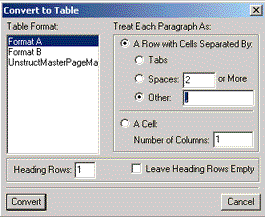Importing tabular data into FrameMaker
July 6, 2006
I had to scrape text from a mainframe screen to a FrameMaker document. The process required scraping the text from the screen, pasting into an empty Notepad and then deleting the unrequired information from the tabular data and then copy-pasting data into the FM doc. It was a cumbersome process and I had dozens of screens to work with.
Being the lazy person I am, I decided to find out if I could find a process to make the process simple. This was the result.
- I copied the data from the screen onto a text doc. The resulting output had commas as separators.
- Next I saved the file as a csv file and imported the same in Microsoft Excel.
- I then started deleting the columns that weren’t required and sorted the data.
- I proceeded to save the file as a csv file.
- In FrameMaker, I selected the csv file for import. A dialog, ‘Unknown File Type’, popped up and I selected the ‘Text’ option and clicked on the ‘Convert’ button.
- Another dialog, Import Text File by Copy, popped up with three options. I selected ‘Convert Text To Table…’ option and clicked on ‘Import’.
- The next dialog, Convert to Table’ listed the various table formats available in the document and also the options on how to convert the text to table. I selected comma as a separator as shown in the figure and clicked on ‘Convert’
- The data was now present as a table in FrameMaker for additional formatting.

Delivering documentation as feeds
January 19, 2006
Sometime back, Suman had put an interesting idea on using RSS feeds as a delivery mechanism. As I read his ideas, I noticed he spoke more on the positive aspects of producing documentation in the form of feeds. Well, it is one of those ideas that had struck me as real great and then the next instant, it looks a bad one.
Playing the devil’s advocate, I have a few points on the idea of Documentation in RSS Formats.
-
A product that connects to the web or uses the web as a medium will benefit greatly from having the documentation of the product in RSS. If it doesn’t connect to the web, then it wouldn’t be a great idea to produce documentation as feeds. Consider a web-based CRM tool and a standalone CRM tool, which would benefit from feeds more.
-
Which format to use for delivering? RSS, Atom, or any of the other major contenders. There is a big debate going on which XML-format to use for feeds. But it wouldn’t be a major issue given the availablity of converters from one format to another.
-
The feed subscription mechanism is growing simpler with auto-discovery and subscription features, but it is to be perfected still.
-
In my short experience as a technical writer, I haven’t got an opportunity yet to generate XML through FrameMaker, but I know that whatever XML is generated ought to conform to the standards. The reason being well-formedness(does this word exist?) of feeds. Microsoft has announced that the next version of Internet Explorer will support only valid feeds, and I’ve noticed most aggregators reject ill-formed feeds. This issue can be taken care by an understanding of the delivery format.
Documentation in the form of feeds would be a great move, a win-win situation for developers and users in the long run. XML Feeds should definitely be one of the delivery mechanisms for documentation in the future. Maybe someday it might be the only way to deliver documentation. How soon is the question.
Modified slightly from my Documentation as Feeds post at my personal blog.
Technorati tags: feeds, documentation, technical writing, ideas, syndication
Hello world!
January 19, 2006
One of the questions I really hate answering is “What do you do?”. The inevitable answer follows countered by either a confused look or a look normally reserved for beggars.
When I decided I wanted to be a technical writer, few well-meaning folks thought I was wasting my life. Some even thought I was wasting my education and therefore, my life. I still field questins from them if I am interested in some other line of work. I can only grimace and smile the question away.
This blog would possibly be an outlet of thoughts relating to technical writing, but also maybe extending to related fields of usability and information architecture.